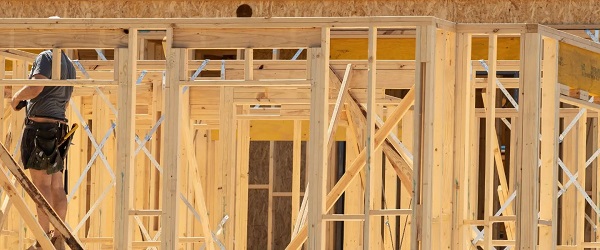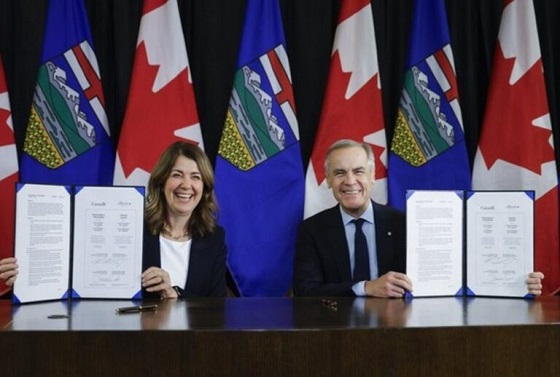Business
Feds to spend $13 billion taxpayer dollars to solve housing crisis they’ve mismanaged for years

From the Fraser Institute
By Jake Fuss and Austin Thompson
Prime Minister Mark Carney recently launched his new “Build Canada Homes” federal agency, which will help build “4,000 factory-built homes” at an initial cost of $13 billion. In light of the affordability crisis that’s plagued large swaths of the country, many Canadians likely welcome more government involvement in the housing sector. But does Ottawa have the ability to efficiently and effectively build homes?
To help answer that question, it’s helpful to consider the federal government’s real estate record. Most Canadians probably aren’t aware that the government owns a bloated portfolio of underused office space, yet efforts to shrink this portfolio have moved at a glacial pace. In 2017, the government acknowledged that half of its office space was underused. But it took until 2019 to formulate a plan to sell off these properties, and by 2023 the federal office footprint (managed by the Department of Public Services and Procurement) was barely reduced—from 6.0 million to 5.9 million square metres.
In light of this failure, the government in 2024 dedicated $1.1 billion in taxpayer money, over 10 years, to hasten the sale of underused federal properties and save taxpayers $3.9 billion in the first decade and $0.9 billion annually thereafter.
Unfortunately, this initiative is already failing. The original goal was to cut the federal office footprint by 50 per cent by 2034, but the government’s current projections envision only a 33 per cent reduction. That means taxpayers will shoulder the cost of maintaining more underused office space each year. And even after a decade and $1.1 billion spent, Ottawa will still be left with roughly one million square metres of idle federal office space.
Why?
According to an auditor general report released in 2025, the federal government lacks even basic data on its own real estate portfolio, routinely misses internal targets for consolidation, and continues to rely on a lengthy process that takes six to eight years to offload surplus buildings. Poor cooperation between federal departments has made matters worse. Nearly half of the largest departments have refused to sign space-reduction agreements, especially those that paid no rent and therefore had no clear financial incentive to give up empty offices.
These failures raise a key question: If the federal government cannot efficiently downsize its own office footprint—despite ample funding and years of effort—how can it credibly promise to deliver complex housing projects?
Which takes us back to the Carney government’s new federal agency, Build Canada Homes (BCH), which plans to develop affordable housing and accelerate housing innovation. But BCH will likely face the same pitfalls that plagued Ottawa’s real estate downsizing effort—namely, poor coordination across the government, competing political priorities, and no real pressure to deliver.
The plan for BCH relies on federal departments to work smoothly with each other, the provinces, municipalities, Indigenous governments and the private sector. BCH is already weighed down by competing mandates. It promises to develop more affordable homes, but only if they’re built with Canadian-made and climate-friendly materials. These goals are at odds. If a product requires a government mandate to be used, it’s not the most cost-effective option.
And taxpayers will give BCH $3.5 billion a year without any clear indication of what we’ll get in return. BCH’s plan promises “significant” numbers of “affordable” homes—with no indication of how the government will measure progress or affordability. How will Canadians know whether the program is on track? Or if it provides good value for tax dollars? These are fundamental questions, especially since there’s a clear risk that BCH spending may simply compete with private-sector development rather than add greatly to the overall stock of houses.
The stakes are high. If Build Canada Homes underperforms, Canadians could be left with few new homes and a considerable bill. Ottawa cannot efficiently downsize its own office footprint despite ample funding and years of effort. That record hardly inspires confidence in its promise to deliver complex housing projects across the country.

Austin Thompson
Business
Canada needs serious tax cuts in 2026

What Prime Minister Mark Carney gives with his left hand, he takes away with his right hand.
Canadians are already overtaxed and need serious tax cuts to make life more affordable and make our economy more competitive. But at best, the New Year will bring a mixed bag for Canadian taxpayers.
The federal government is cutting income taxes, but it’s hiking payroll taxes. The government cancelled the consumer carbon tax, but it’s hammering Canadian businesses with a higher industrial carbon tax.
The federal government cut the lowest income tax bracket from 15 to 14 per cent. That will save the average taxpayer $190 in 2026, according to the Parliamentary Budget Officer.
But the government is taking more money from Canadians’ paycheques with higher payroll taxes.
Workers earning $85,000 or more will pay $5,770 in federal payroll taxes in 2026. That’s a $262 payroll tax hike. Their employers will also be forced to pay $6,219.
So Canadians will save a couple hundred bucks from the income tax cut in the new year, but many Canadians will pay a couple hundred bucks more in payroll taxes.
It’s the same story with carbon taxes.
After massive backlash from ordinary Canadians, the federal government dropped its consumer carbon tax that cost average families hundreds of dollars every year and increased the price of gas by about 18 cents per litre.
But Carney’s first budget shows he wants higher carbon taxes on Canadian businesses. Carney still hasn’t provided Canadians a clear answer on how much his business carbon tax will cost. He did, however, provide a hint during a press conference he held after signing a memorandum of understanding with the Alberta government.
“It means more than a six times increase in the industrial price on carbon,” Carney said.
Carney previously said that by “changing the carbon tax … We are making the large companies pay for everybody.”
Carney’s problem is that Canadians aren’t buying what he’s selling on carbon taxes.
Just 12 per cent of Canadians believe Carney that businesses will pay most of the cost of his carbon tax, according to a Leger poll. Nearly 70 per cent of Canadians say businesses will pass most or some of the cost to consumers.
Canadians understand that it doesn’t matter what type of lipstick politicians put on their carbon tax pig, all carbon taxes make life more expensive.
Carney is also continuing his predecessor’s tradition of automatically increasing booze taxes.
Ottawa will once again hike taxes on beer, wine and spirits in 2026 through its undemocratic alcohol tax escalator.
First passed in the 2017 federal budget, the alcohol escalator tax automatically increases federal taxes on beer, wine and spirits every year without a vote in Parliament.
Federal alcohol taxes are expected to increase by two per cent on April 1, and cost taxpayers $41 million in 2026. Since being imposed, the alcohol escalator tax has cost taxpayers about $1.6 billion, according to industry estimates.
Canadians are overtaxed and need the federal government to seriously lighten the load.
The biggest expense for the average Canadian family isn’t the home they live in, the food they eat or the clothes they buy. It’s the taxes they pay to all levels of government. More than 40 per cent of the average family’s budget goes to paying taxes, according to the Fraser Institute.
Politicians are taking too much money from Canadians. And their high taxes are driving away investment and jobs.
Canada ranks a dismal 27th out of 38 industrialized countries on individual tax competitiveness, according to the Tax Foundation. Canada ranks 22nd on business tax competitiveness. Canada is behind the United States on both measures.
A little bit of tax relief here and there isn’t going to cut it. Carney’s New Year’s resolution needs to be to embark on a massive tax cutting campaign.
Business
DOOR TO DOOR: Feds descend on Minneapolis day cares tied to massive fraud

Federal agents are now going “DOOR TO DOOR” in Minneapolis, launching what the Department of Homeland Security itself describes as an on-the-ground sweep of businesses and day-care centers tied to Minnesota’s exploding fraud scandal — a case that has already burned through at least $1 billion in taxpayer money and is rapidly closing in on Democrat Gov. Tim Walz and his administration.
ICE agents, working under the umbrella of the Department of Homeland Security, fanned out across the city this week, showing up unannounced at locations suspected of billing state and federal programs for services that never existed. One day-care worker told reporters Monday that masked agents arrived at her facility, demanded paperwork, and questioned staff about operations and enrollment.
“DHS is on the ground in Minneapolis, going DOOR TO DOOR at suspected fraud sites,” the agency posted on X. “The American people deserve answers on how their taxpayer money is being used and ARRESTS when abuse is found.”
DHS is on the ground in Minneapolis, going DOOR TO DOOR at suspected fraud sites.
The American people deserve answers on how their taxpayer money is being used and ARRESTS when abuse is found. Under the leadership of @Sec_Noem, DHS is working to deliver results. pic.twitter.com/7XtRflv36b
— Homeland Security (@DHSgov) December 29, 2025
Authorities say the confirmed fraud already totals roughly $300 million tied to fake food programs, $220 million linked to bogus autism services, and more than $300 million charged for housing assistance that never reached the people it was meant to help. Investigators from the FBI, Justice Department, and Department of Labor have now expanded their probes after a viral investigation exposed taxpayer-funded day cares that received more than $1 million each while allegedly serving few — or zero — children.
One of the most glaring examples, the Minneapolis-based Quality “Learing” Center — infamous for its misspelled sign — suddenly appeared busy Monday as national media arrived. Locals told reporters the center is typically empty and often looks permanently closed, despite receiving about $1.9 million in public funds. State inspection records show the facility has racked up 95 violations since 2019. Employees allegedly cursed at reporters while children were bused in during posted afternoon hours.
DHS officials say the “DOOR TO DOOR” operation is deliberate. In videos released online, agents are seen questioning nearby business owners about whether adjacent buildings ever had foot traffic, whether they appeared open, and whether operators used subcontractors or outside partners to pad billing. DHS Secretary Kristi Noem posted footage of agents pressing workers about business relationships and transportation services used by suspected fraud sites.
“This is a large-scale investigation,” DHS Assistant Secretary Tricia McLaughlin told the New York Post, confirming that Homeland Security Investigations and ICE are targeting fraudulent day-care and health-care centers as well as related financial schemes.
FBI Director Kash Patel warned that what investigators have uncovered so far is “just the tip of a very large iceberg.” He pointed to the bureau’s dismantling of a $250 million COVID-era food-aid scam tied to the Feeding Our Future network, a case that resulted in 78 indictments and 57 convictions. Patel has also made clear that denaturalization and deportation remain on the table for convicted fraudsters where the law allows.
Dozens of arrests have already been made across the broader scheme, many involving Somali immigrants, though federal officials stress the investigation targets criminal behavior — not communities. Some local residents say the scandal is hurting law-abiding families. One Somali Uber driver told reporters he works 16-hour days and is furious that “some people are taking advantage of the system,” making the entire community look bad.
Now, with federal agents going “DOOR TO DOOR” across Minneapolis, the era of polite indifference appears to be over. The message from Washington is blunt: the money trail is being followed, the paperwork is being checked, and the days of treating taxpayer-funded programs like an open vault are coming to an end.
-

 Alberta2 days ago
Alberta2 days agoAlberta Next Panel calls to reform how Canada works
-

 International2 days ago
International2 days agoGeorgia county admits illegally certifying 315k ballots in 2020 presidential election
-

 Business2 days ago
Business2 days agoThe “Disruptor-in-Chief” places Canada in the crosshairs
-

 Artificial Intelligence2 days ago
Artificial Intelligence2 days agoUK Police Pilot AI System to Track “Suspicious” Driver Journeys
-

 Energy2 days ago
Energy2 days ago‘The electric story is over’
-

 Business2 days ago
Business2 days agoWarning Canada: China’s Economic Miracle Was Built on Mass Displacement
-

 Energy2 days ago
Energy2 days agoThe Top News Stories That Shaped Canadian Energy in 2025 and Will Continue to Shape Canadian Energy in 2026
-

 Daily Caller24 hours ago
Daily Caller24 hours agoUS Halts Construction of Five Offshore Wind Projects Due To National Security







